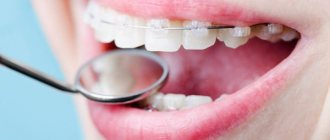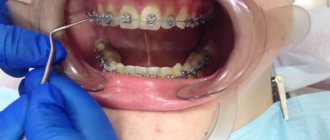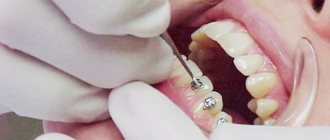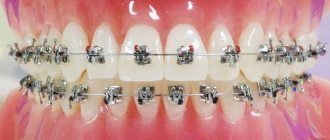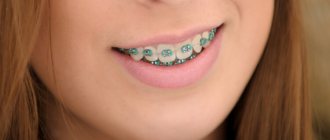Which braces are better: ceramic or metal?
Before starting treatment, each patient should discuss with the doctor and decide for themselves what is more important - the issue of aesthetics or a quick result.
Important!
The main difference between ceramic braces and metal ones is that the former will be barely noticeable on the teeth, allowing you to go through the correction period without psychological discomfort, while the latter will correct existing problems in a faster time.
Metal braces are characterized by increased efficiency, since both the brackets and the arches of the system are made of metal, which allows minimizing the friction force between the elements of the product and affecting the teeth more evenly. Therefore, in complex orthodontic cases, doctors offer this option. The material from which iron structures are made does not corrode no matter how long they are worn.
Ceramic systems, despite their advantages in terms of aesthetics, have their drawbacks - they are more fragile and prone to breakage, and require careful wearing. From a material point of view, they are more expensive when compared with metal products.
How to choose the right system
Due to the fact that the products are worn for many months, the first thing patients pay attention to is aesthetics and inconspicuousness. The difference between ceramic and sapphire braces is significant, because they are made from completely different materials.
While ceramic products are matched to the color of tooth enamel, sapphire systems are completely transparent. The disadvantage of the latter is that if the teeth are not very white, then transparent systems will stand out against their background.
The advantage of ceramic structures is that the doctor can choose the matte finish of the surface to achieve maximum aesthetic results. So, with the help of the right professional tactics, the staples will merge with each other, and due to this they will become completely invisible.
Sapphire devices are products made from monocrystalline ceramics, since transparent locks are made from artificial sapphires. Ceramic devices are a collection of tiny crystals, while each sapphire lock is a separate crystal element.
Painstaking processing ensures the achievement of an effect similar to the sparkling of diamonds: when the sun hits the best, the smile will shimmer beautifully. Moreover, such devices completely blend with the shade of the teeth and become invisible to others.
Sapphire braces
The second very important criterion is practicality when chewing food. Both sapphires and ceramics do not give a person any unpleasant sensations, but there are certain points that you need to pay attention to when choosing.
So, ceramics are not suitable for tea and coffee lovers, because if these drinks are abused, they tend to darken. Such brace-bearers need to completely forget about toffee, coloring products and nuts. Sapphires win in this regard, but they are considered more fragile.
A huge role in the choice of systems is played by the severity of the pathology and the duration of operation of the products.
Sapphires and ceramics will be an excellent solution, especially if your problem is not very advanced and the wear period of the products will be no more than one year.
If you still need therapy, experts advise installing metal products, because beauty requires sacrifice, namely, a longer period of use.
We suggest you familiarize yourself with Dry mouth, dizziness, weakness, nausea, causes.
Pricing remains a top priority for many. The cost of the system will directly depend on the model and manufacturer.
Popular models
Examples of metal braces from well-known manufacturers.
- Incognito (USA) - lingual type constructions, recognized as the best in their group. They are placed on the inside of the teeth and have high strength indicators, but due to their cost they are chosen less often than products from other manufacturers.
- Mini Master (USA) - the smallest braces available. They have a ligature type. Comfortable to wear, highly effective.
- Mini Diamond (USA) - ligature structures made from high-quality steel. Characterized by obtaining accelerated treatment results.
- STB (USA) - lingual braces that fully meet the requirements of reliability and aesthetics. They require a long adaptation process compared to vestibular structures.
- Damon (USA) - represented by two self-ligating models Q and MX3. Their production uses computer and innovative technologies to correct orthodontic problems even in complex cases.
- H4 (USA) - non-ligature low-profile braces capable of self-regulation. The compactness of the model increases its aesthetics when worn.
- Victory (USA) - classic metal ligature braces, comfortable and aesthetically pleasing due to their low profile. They are easy to install, since the composite glue is applied by the manufacturer to the areas of future fixation of the plates at the production stage.
- WIN (Germany) - invisible and functional metal braces of lingual type. They are comfortable and reliable to wear and do not cause long-term adaptation or discomfort during the treatment process.
- In-Ovation (USA) - the manufacturer's metal self-ligating structures are represented by two models L and Mini. The products have an anatomical base for each tooth, allowing the simultaneous combination of active and passive alignment forces to achieve optimal correction results.
Ceramic braces are constantly being improved. Examples of designs from well-known manufacturers.
- Damon Clear, Damon Clear 2 (USA) – the transparent properties of pigmentation-resistant ceramics have been appreciated by thousands of patients for whom effective treatment of bite problems and abnormal tooth position is important in tandem with the aesthetic component.
- Damon 3 (USA) - a combination of a ceramic base and metal grooves allows the product to look miniature and aesthetically pleasing on the teeth, while maintaining reliability and durability.
- Clarity SL (USA) is a ceramic model of braces that uses metal grooves to fix the arch. This combination helps speed up the teeth straightening process without losing its effectiveness.
- In-Ovation (USA) - self-ligating ceramic brackets that have a special arch attachment system and a mesh base for better positioning of each tooth.
Installation and duration of treatment
The preparatory period before installation is the same for all types of braces:
- At the first consultation, the dentist examines the patient's oral cavity for the presence of caries or other diseases.
Braces are not installed if there are any oral diseases. If there are problems, the doctor prescribes treatment and also gives information about the approximate cost of treatment. Treatment before installation lasts no more than a year if the problems are not serious. If the case is complex, then the doctor may adjust something during the process. - Next, you need to take an X-ray of the skull, a panoramic photograph of the teeth, and a profile and frontal photo of the patient. After this, the doctor gives precise recommendations, tells you the duration of wearing braces and the exact price.
- The installation procedure of the products does not take much time.
It takes about 2 hours to attach the system to the teeth using special glue. Archwires are then inserted into the slots to apply pressure to the teeth. The procedure is painless. Adaptation to the orthodontic system is quick; after a couple of days the patient does not feel discomfort. If you need to reduce the length of time you wear braces, the dentist will increase the pressure on your teeth, but itching and pain will accompany you for several days.
You can save some money if you install sapphire braces only on the front of your teeth and metal on the sides.
The duration of wearing braces is determined individually. The average treatment period is 1 year. If the problems are serious, the period can be extended to two years or more.
The installation of braces affects the oral cavity and sometimes complications are possible, as local immunity is reduced. Complications include gum inflammation, caries, etc.
To avoid this, it is recommended to take immunostimulating medications as prescribed by your doctor. This will help reduce the number of microbes in the oral cavity and slow down their reproduction, reduce bleeding gums and the formation of plaque on teeth.
Removing orthodontic structures is painless and takes little time.
Comparison
When comparing ceramic and metal braces, it is important to note that the former do not cause pigmentation of the teeth.
- Iron structures can leave marks, especially with prolonged treatment, for this reason many adult patients refuse to wear them in favor of a ceramic system.
- Metal braces are distinguished by affordable prices, durability and greater strength compared to ceramics. But leveling ceramic structures have a significant advantage in aesthetics - the plates adapt to the color of the teeth, becoming unnoticeable to others, which cannot be said about their iron counterparts.
- When choosing between materials - ceramics or metal, you need to remember that the first will be more fragile, prone to frequent breakdowns and cracks if worn carelessly. Unplanned repairs and unscheduled visits to the orthodontist will significantly increase the cost of treatment.
- During the adaptation period, metal braces often provoke diction defects, unlike ceramic braces, which are faster and easier to get used to. They can also cause allergic reactions, which is excluded with ceramic products.
- When wearing metal structures, a person continues to eat familiar foods, limiting only hard and coarse foods. Nutrition when wearing ceramic braces is subject to more strict adjustments, since they are less durable. The patient should avoid solid foods, seeds, nuts, toffees, and chewing gum. The orthodontist may also recommend quitting smoking, avoiding coffee and red wine to avoid staining the system.
Both types of brace systems require high-quality care. Metal structures are easier to care for; ceramics require a more delicate attitude due to their fragility and tendency to stain.
Kinds
To solve the problem of straightening the teeth, a modern orthodontist has an arsenal consisting of four types of braces: sapphire, metal, ceramic and lingual. At the moment, all these types of brace systems are used, but each has not only its own characteristics, but also its own disadvantages and advantages. For example, the most tried and tested option is metal braces, which work faster than others, cost less, but are inferior to their counterparts from an aesthetic point of view. Lingual braces are installed on the back of the dentition and are not visible to others at all, but their use is not always possible due to clinical limitations, so sapphire and ceramic braces can be safely called one of the most optimal options from all points of view.

